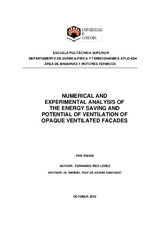Mostrar el registro sencillo del ítem
Numerical and experimental analysis of the energy saving and potential of ventilation of opaque ventilates facades
| dc.contributor.advisor | Ruiz de Adana, Manuel | |
| dc.contributor.author | Peci López, Fernando | |
| dc.date.accessioned | 2013-01-15T13:05:31Z | |
| dc.date.available | 2013-01-15T13:05:31Z | |
| dc.date.issued | 2013 | |
| dc.identifier.uri | http://hdl.handle.net/10396/8649 | |
| dc.description.abstract | Nowadays the efficient use of energy is a crucial necessity. Buildings are among the greater energy consumers in a country and the ventilation and HVAC systems account for a high percentage of this consumption. A way of reducing the energy consumption of these systems is taking advantage of the renewable energies available. In this document an opaque ventilated façade (OVF) was studied. An OVF takes advantage of the wind force and solar radiation to provide the indoor space with free ventilation and air preheating. The objectives of the study were: find evidence of this possible advantages, quantify the potential of an OVF to provide ventilation and heating in different situations and study the sensibility of the system to variation of the most important parameters. For this purpose an experimental module of OVF was built and monitorized, and a model was configurated and validate with the experimental data. With this model, simulations were carried out to study the performance of the OVF with the variations of estimated parameters and design parameters. It was also tested the performance of the OVF under different climatic conditions in several climatic areas of Spain. The results showed that for any climatic zone the OVF could provide buildings with free ventilation. However the flow rates yielded weren’t sufficient to meet the regulation requirement so this system would require mechanical ventilation support. The results also showed that the heating energy consumption could be reduced by two means: preheating the ventilation air and introducing ventilation air in non occupancy periods at a convenient temperature. From the sensibility study it could be concluded that the external and internal convection coefficients, and the solar absortivity were key parameters for predicting the energy savings an OVF could provide. | es_ES |
| dc.format.mimetype | application/pdf | es_ES |
| dc.language.iso | eng | es_ES |
| dc.publisher | Universidad de Córdoba, Servicio de Publicaciones | es_ES |
| dc.rights | https://creativecommons.org/licenses/by-nc-nd/4.0/ | es_ES |
| dc.subject | Ahorro energético | es_ES |
| dc.subject | Consumo energético | es_ES |
| dc.subject | OVF (Opaque Ventilated faÇade) | es_ES |
| dc.title | Numerical and experimental analysis of the energy saving and potential of ventilation of opaque ventilates facades | es_ES |
| dc.type | info:eu-repo/semantics/doctoralThesis | es_ES |
| dc.rights.accessRights | info:eu-repo/semantics/openAccess | es_ES |

